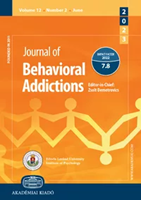Emotional interference and attentional bias in compulsive sexual behaviors disorder – An fMRI study on heterosexual males
Emotional interference and attentional bias in compulsive sexual behaviors disorder – An fMRI study on heterosexual males
Author(s): Małgorzata Draps, MARIA KULESZA, Agnieszka Glica, JULIA SZYMANOWSKA, KATARZYNA LEWINSKA, Weronika Żukrowska, Mateusz GolaSubject(s): Individual Psychology, Clinical psychology, Behaviorism, Substance abuse and addiction, Health and medicine and law
Published by: Akadémiai Kiadó
Keywords: compulsive sexual behaviors disorder; emotional processing; emotional interference effect; cognitive conflict; attentional bias; problematic pornography use;
Summary/Abstract: Background and aims: Despite the inclusion of the Compulsive Sexual Behavior Disorder (CSBD) in the 11th edition of the International Classification of Diseases, emotional and cognitive impairments related to CSBD remains unclear. This study aimed to investigate the behavioral and neuronal effects of emotional interference on cognition among CSBD patients. Methods: Thirty heterosexual males with CSBD and matched healthy controls (HC) were studied with the Emotional Stroop Task using 5 categories of emotionally arousing words (sex-related, positive, fear-related, negative, neutral) during functional magnetic imaging. Results: At the behavioral level, we found the main effect of the condition: sex-related words evoked a stronger Stroop effect than other conditions. At the neural level, we found a significant group effect. Among CSBD patients processing of sex-related words was related to increased activity in the right putamen, right thalamus, hippocampi, and left pulvinar, when compared to HC. We also found a negative correlation between neuronal activation and time spent on sexual activity during the week preceding study and numerous group differences in brain regions connected to the emotional and motivational processing of sexually explicit material, correlating with CSBD symptoms. Conclusions: Behavioral results indicate a specific attentional bias toward sex-related stimuli in both groups, while neural data uncovered stronger reactivity to sex-related words in CSBD compared to HC. This reactivity is related to CSBD symptoms and provides evidence for the interference of sex-related stimuli with cognition. Such results are firmly in line with the Incentive Salience Theory and conceptualizing CSBD as a behavioral addiction.
Journal: Journal of Behavioral Addictions
- Issue Year: 13/2024
- Issue No: 3
- Page Range: 791-806
- Page Count: 16
- Language: English

